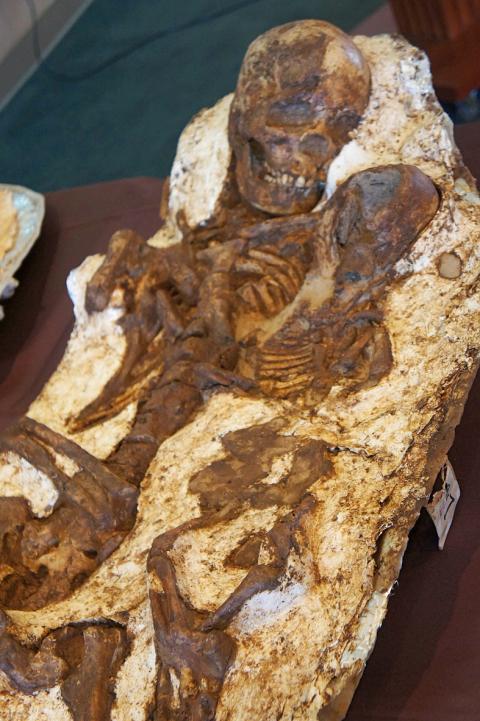The 48 sets of remains unearthed in graves in the Taichung area are the earliest trace of human activity found in central Taiwan. The most striking discovery among them was the skeleton of a young mother looking down at a child cradled in her arms.

Archaeologists in Taiwan have found a 4,800-year-old human fossil of a mother holding an infant child in her arms, museum officials said on Tuesday.
The 48 sets of remains unearthed in graves in the Taichung area are the earliest trace of human activity found in central Taiwan. The most striking discovery among them was the skeleton of a young mother looking down at a child cradled in her arms.
“When it was unearthed, all of the archaeologists and staff members were shocked. Why? Because the mother was looking down at the baby in her hands,” said Chu Whei-lee, a curator in the Anthropology Department at Taiwan’s National Museum of Natural Science.

The excavation of the site began in May 2014 and took a year to complete. Carbon dating was used to determine the ages of the fossils, which included five children.
The Origins of the Mummified Mother and Baby
The scientific excavation began in 2014 and took about a year to complete.
A team of archaeologists led by Chu Whei-Lee of Taiwan’s National Museum of Science was working on a Neolithic site 6.2 miles (10 kilometres) inland from Taiwan’s western coast.
Today, that area is called Taichung City but the site itself has been dubbed An-ho. Experts believe shorelines have shifted over the years and that An-ho was once a coastal village.

Indeed, over 200 shark teeth have been found in the site’s dwellings, however, whether these teeth were practical, decorative, or spiritual is not known. The inhabitants of An-ho were most likely Dabenkeng people.
“The Dabenkeng people were the first farmers in Taiwan, who may have come from the south and southeast coasts of China about 5,000 years ago,” says Chengwha Tsang of Taiwan’s Academia Sinica. “This culture is the earliest Neolithic culture so far found in Taiwan.” Taiwanese Dabenkeng culture featured corded ware pottery and stone adzes.
While the Dabenkeng lasted until the 3rd millennium BC in Mainland China, Taiwanese Dabenkeng lasted only until around 4,500 BC.
Yet from Taiwan, the Dabenkeng spread across Southeast Asia and Oceania, bringing their culture and language with them.
“They were probably the earliest ancestors of the Austronesian language-speaking people living nowadays in Taiwan and on the islands of the Pacific,” said Tsang.





